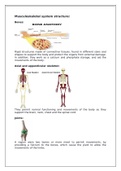Musculoskeletal system structure:
Bones:
Rigid structures made of connective tissues, found in different sizes and
shapes to support the body and protect the organs from external damage.
In addition, they work as a calcium and phosphate storage, and aid the
movements of the body.
Axial and appendicular skeleton:
They permit normal functioning and movements of the body as they
support the brain, neck, chest and the spinal cord.
Joints:
A region were two bones or more meet to permit movements, by
providing a fulcrum to the bones, which cause the pivot to allow the
movements of the limbs.
,Cartilages:
Flexible connective tissues, coating the surface inside the joints, bones,
spinal cord and the ribcage.
Ligaments:
By connecting two bones together they provide stabilisation to the joints
and the body.
Tendons:
Flexible connective tissues, connecting the muscle to the bone, allowing
the movements of the limbs
Musculoskeletal system functions:
Supporting the body, and allowing movements, by connecting
different bones to the joints and cartilages, is the main function of
the Musculoskeletal system.
Protecting vital organs, and soft tissues, such as the heart and the
lungs are protected by the rib cage.
Producing red and white blood cells in the bone marrow, filling the
internal cavities of bones.
Storing calcium and phosphate.
,Blood cells production:
Bone marrow:
Generate blood cells, from Hematopoietic and Mesenchymal stem cells.
The Hematopoietic and stem cells are located in the red marrow and are
responsible for producing red and white blood cells as well as platelets
through a process called Haematopoiesis, which promotes the movements
is the musculoskeletal system.
The Mesenchymal stem cells are found in the ligaments and tendons
which support blood and bone cells formation, by producing non-blood cell
components, like fat, cartilage, and fibrous connective tissues
Minerals storage:
Bones act as a storage for minerals, specifically calcium and phosphorus
minerals, as they support the musculoskeletal system by maintaining
bone mass. They are also needed for making healthy bones.
Calcium aids the normal functioning of the muscles, neurons and other
cells, usually found in the teeth, as well as the bones.
, Phosphorus is used for growth, such as producing the proteins needed for
growth or repairing the damaged cells and tissues. Other than that, it is
also needed in the formation of teeth and bones.
Bones, also have fat storage where fatty acids get stored in the bone
marrow adipose tissue.
Bones can maintain the right level of pH in the blood as they can absorb
and release alkaline salts. It can also balance the level of calcium in the
blood as it is able to form bone and break it down through a process
named resorption.




